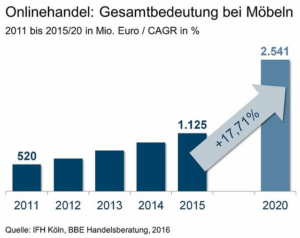The biggest challenge of the furniture industry
The furniture industry is experiencing a massive upheaval, the extent of which can hardly be determined at present. But all of the top managers I interviewed in the industry agree on one thing: the biggest challenge is digitisation! But what exactly is meant by this? Digitised processes, e-commerce, competition from «pure players», block chain in procurement, same-day delivery? The facets of digitisation that make life difficult for the sedate bricks-and-mortar furniture trade are extensive. I will highlight the most important ones below:

Online trade is certainly the spearhead of digitisation. It pierces the heart of the traditional, primarily bricks-and-mortar furni-ture companies. Forecasts exist that say that, by the end of next year, around one third of the 30,000 German furniture shops that existed in 2017 will have disappeared – because of online trade!
Only those that pursue a comprehensive, customer-focused digitisation strategy are likely to survive. Convenience, choice, added value and transparency must be the main focus for the customer.
Augmented reality (AR) and virtual reality (VR) will of course also play a role. It should be noted that gadgets are still generating little turnover at the moment, as I experienced myself. Nevertheless, sooner or later this technology will play an important role. It’s just a question of when! For the time being, the primary needs that digitisation must fulfil for the customer are the focus: How do I find the right product for me? On the one hand, digitised tools like «line extension» or configurators allow us to offer a vast number of products, but is the right one for me as a customer there? How can I offer the customer suitable advice online? At the moment, bots are not even close to meeting these requirements, nearshore online consulting is not exactly cheap (set-up, quality and operation), and a traditional call centre is probably not the solution of the future. In this regard, small-format shops will play a very important role in the modern multi-channel furniture industry. In these stores it will be possible to obtain samples, advice can be given and orders can be collected, etc. The term ROPO, in my opinion, is not dynamic enough in this regard. The customer of today – and tomorrow’s customer even more so – jumps back and forth between the channels, constantly. This would appear to be logical but is hardly measurable, and this makes it a bit of a mystery for retailers, who are used to being able to follow their customers at every turn.
In this context, customer journeys no longer really live up to their ascribed meaning, and yet they are still needed to demonstrate the various «media forms».

Digitisation has become unmistakable. Nobody buys furniture nowadays without first obtaining information online. Nobody buys an expensive interior design item without checking it out on Google beforehand. What is reported about it, are there any ratings? Is the price right, what do I have to take note of, etc? And yet very traditional patterns of behaviour/touchpoints are still visible: friends, word of mouth, PR. We can deduce from this that image is important. Despite all of the discount battles that the major suppliers are engaged in, we must not underestimate the image component when purchasing such a substantial item as a sofa. But this takes place continuously! As a consumer, do I really want to buy an item from a «furniture store» that is constantly offering discounts and rarely demonstrates its primary service? Take a look at the homepage of all well-known, (traditional) major furniture stores. Same design, same navigation, same hook: price! Compare this to the «pure players»: real inspiration! But shouldn’t the bricks-and-mortar retailers be the real inspiration professionals? The situation is similar for the rest of the communication activities. Image advertising has almost become a dirty phrase among bricks-and-mortar retailers, as I’ve experienced myself!
What exactly does an online presence do? It goes without saying that for pure players it’s everything. For multi-channel (but mainly bricks-and-mortar) providers is it just one shop, one branch? It often appears that way, and standards thus fall short. Even if the online shop generates sales, it must be tailored more precisely to the needs of the customer journey based on the ROPO effect. Retailer-specific core competences, as well as distinguishing characteristics, should be recognizable, because the customer decides whether or not they will go to the store based on these aspects! It is simply impossible for virtually everyone to stand out based on price. So do your homework, please!
There’s a lot to think about, and this is all the more important in relation to digitisation. This battle for survival will not be won by the store with the best technical affinity, but by the one that knows its customers and their needs the be
